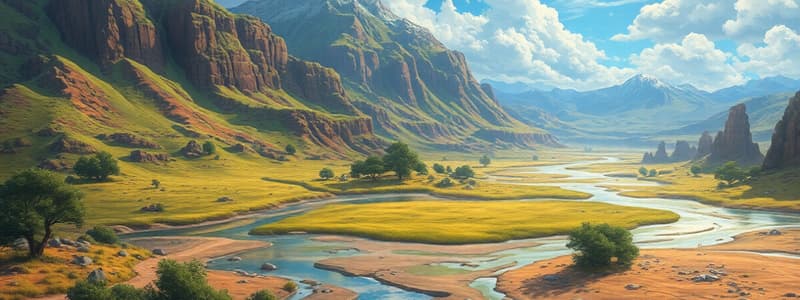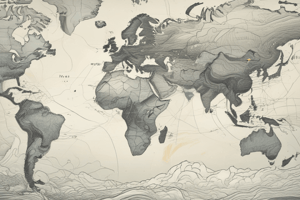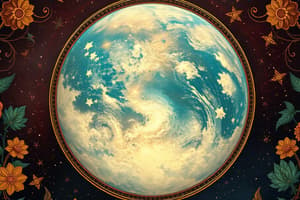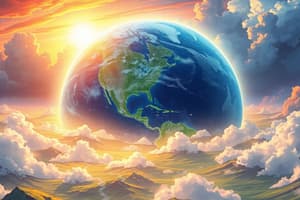Podcast
Questions and Answers
ما معالم سطح الأرض؟
ما معالم سطح الأرض؟
تشمل معالم سطح الأرض الشواطئ الرملية والشواطئ الصخرية، والتلال، والهضاب، والجبال، والصحاري، والوديان، وقد تشاهد البحار والأنهار والبحيرات.
أيٌّ مِنَ الْـمَـعَـالِمِ الـتَّـالِيةِ يُـشَـكِّـلُ مَعَـالِمَ اليَـابِسَةِ؟
أيٌّ مِنَ الْـمَـعَـالِمِ الـتَّـالِيةِ يُـشَـكِّـلُ مَعَـالِمَ اليَـابِسَةِ؟
- الـمُـصْـبُ
- الـجِـبَـالُ (correct)
- النَّهْـر
- الـبـحْرَةَ
أيٌّ مِنَ الْـمَـعَـالِمِ الـتَّـالِيةِ يُـشَـكِّـلُ مَعَـالِمَ الـمِيَـاهِ؟
أيٌّ مِنَ الْـمَـعَـالِمِ الـتَّـالِيةِ يُـشَـكِّـلُ مَعَـالِمَ الـمِيَـاهِ؟
- الـخَـانِقُ
- الـوَادِي
- الـسَّـهْلُ
- الـبَحْـر (correct)
يُسمى كُلٌّ مِنَ الـفَحْمِ الـحَـجَرِيِّ وَالنَّـفْـطِ وَالـغَـازِ الطَّبِيعِيِّ الـوَقُـودِ الـأَحْفُورِيّ.
يُسمى كُلٌّ مِنَ الـفَحْمِ الـحَـجَرِيِّ وَالنَّـفْـطِ وَالـغَـازِ الطَّبِيعِيِّ الـوَقُـودِ الـأَحْفُورِيّ.
ما أَسَـمَـاءُ مَـصَـادِرِ الـطَّـاقَـةِ الـغَـيْـرِ الـمُـتَـجَـدِدَةِ؟
ما أَسَـمَـاءُ مَـصَـادِرِ الـطَّـاقَـةِ الـغَـيْـرِ الـمُـتَـجَـدِدَةِ؟
ما أَسَـمَـاءُ مَـصَـادِرِ الـطَّـاقَـةِ الـمُـتَـجَـدِدَةِ؟
ما أَسَـمَـاءُ مَـصَـادِرِ الـطَّـاقَـةِ الـمُـتَـجَـدِدَةِ؟
كَيْـفَ يُـمْكِنُ إِنْتَاجَ الـطَّـاقَـةِ مِنَ الـشَّـمْسِ؟
كَيْـفَ يُـمْكِنُ إِنْتَاجَ الـطَّـاقَـةِ مِنَ الـشَّـمْسِ؟
كَيْـفَ يُـمْكِنُ إِنْتَاجَ الـطَّـاقَـةِ مِنَ الـمِيَـاهِ؟
كَيْـفَ يُـمْكِنُ إِنْتَاجَ الـطَّـاقَـةِ مِنَ الـمِيَـاهِ؟
Flashcards
ما هي التضاريس؟
ما هي التضاريس؟
هي المعالم الطبيعية لسطح الأرض مثل الشواطئ الرملية، والتلال والجبال والصحاري والوديان.
ما هو الجبل؟
ما هو الجبل؟
منطقة مرتفعة كثيرًا فوق سطح الأرض.
ما هو التل؟
ما هو التل؟
أقل ارتفاعًا من الجبل وأكثر استدارة.
ما هو الوادي؟
ما هو الوادي؟
Signup and view all the flashcards
ما هو السهل؟
ما هو السهل؟
Signup and view all the flashcards
ما هي الهضبة؟
ما هي الهضبة؟
Signup and view all the flashcards
ما هي الصحراء؟
ما هي الصحراء؟
Signup and view all the flashcards
ما هو الشاطئ؟
ما هو الشاطئ؟
Signup and view all the flashcards
ما هو البحر أو المحيط؟
ما هو البحر أو المحيط؟
Signup and view all the flashcards
ما هو الساحل؟
ما هو الساحل؟
Signup and view all the flashcards
ما هو النهر؟
ما هو النهر؟
Signup and view all the flashcards
ما هو الرافد؟
ما هو الرافد؟
Signup and view all the flashcards
ما هو الشلال؟
ما هو الشلال؟
Signup and view all the flashcards
ما هي البحيرة؟
ما هي البحيرة؟
Signup and view all the flashcards
ما هو المصب؟
ما هو المصب؟
Signup and view all the flashcards
ما هي الدلتا؟
ما هي الدلتا؟
Signup and view all the flashcards
ما هو الرصيف القاري؟
ما هو الرصيف القاري؟
Signup and view all the flashcards
ما هو المنحدر القاري؟
ما هو المنحدر القاري؟
Signup and view all the flashcards
ما هو المرتفع القاري؟
ما هو المرتفع القاري؟
Signup and view all the flashcards
ما هو ظهر المحيط؟
ما هو ظهر المحيط؟
Signup and view all the flashcards
ما هي الأخاديد البحرية؟
ما هي الأخاديد البحرية؟
Signup and view all the flashcards
ما هي سهول قاعية منبسطة؟
ما هي سهول قاعية منبسطة؟
Signup and view all the flashcards
ما هي الجبال البحرية؟
ما هي الجبال البحرية؟
Signup and view all the flashcards
ما هو الغلاف الجوي؟
ما هو الغلاف الجوي؟
Signup and view all the flashcards
ما هو الغلاف المائي؟
ما هو الغلاف المائي؟
Signup and view all the flashcards
ما هي القشرة الأرضية؟
ما هي القشرة الأرضية؟
Signup and view all the flashcards
ما هو الستار؟
ما هو الستار؟
Signup and view all the flashcards
ما هو اللب؟
ما هو اللب؟
Signup and view all the flashcards
ما هو الغلاف الحيوي؟
ما هو الغلاف الحيوي؟
Signup and view all the flashcards
ما هو الغلاف الصخري؟
ما هو الغلاف الصخري؟
Signup and view all the flashcards
ما هي الصفائح الأرضية؟
ما هي الصفائح الأرضية؟
Signup and view all the flashcards
ما هو الصدع؟
ما هو الصدع؟
Signup and view all the flashcards
ما هو الغلاف المائع؟
ما هو الغلاف المائع؟
Signup and view all the flashcards
ما هو الزلزال؟
ما هو الزلزال؟
Signup and view all the flashcards
ما هي بؤرة الزلزال؟
ما هي بؤرة الزلزال؟
Signup and view all the flashcards
ما هو المركز السطحي للزلزال؟
ما هو المركز السطحي للزلزال؟
Signup and view all the flashcards
ما هو مقياس رختر؟
ما هو مقياس رختر؟
Signup and view all the flashcards
ما هو التسونامي؟
ما هو التسونامي؟
Signup and view all the flashcards
ما هو البركان؟
ما هو البركان؟
Signup and view all the flashcards
ما هي اللابة؟
ما هي اللابة؟
Signup and view all the flashcards
ما هي التجوية؟
ما هي التجوية؟
Signup and view all the flashcards
ما هي التعرية؟
ما هي التعرية؟
Signup and view all the flashcards
ما هو الترسيب؟
ما هو الترسيب؟
Signup and view all the flashcards
ما هي الأحفورة؟
ما هي الأحفورة؟
Signup and view all the flashcards
ما هو الوقود الأحفوري؟
ما هو الوقود الأحفوري؟
Signup and view all the flashcards
ما هي الموارد غير المتجددة؟
ما هي الموارد غير المتجددة؟
Signup and view all the flashcards
ما هي الموارد المتجددة؟
ما هي الموارد المتجددة؟
Signup and view all the flashcards
Study Notes
Table of Contents
- Unit 3: Earth and Its Resources
- Chapter 5: Our Changing Earth
- Lesson 1: Earth's Surface Features
- Scientific writing: The Giant Continents
- Lesson 2: Processes Affecting Earth's Surface
- Act like scientists: How do volcanoes help form islands?
- Chapter 5 review and sample test
- Lesson 1: Earth's Surface Features
- Chapter 6: Protecting Earth's Resources
- Lesson 1: Energy Sources
- Science careers: Geologist, well driller
- Lesson 2: Air and Water
- Science and mathematics: Water on Earth
- Chapter 6 review and sample test
- Lesson 1: Energy Sources
- Chapter 5: Our Changing Earth
- Unit 4: Weather
- Chapter 7: Weather Patterns
- Lesson 1: The Atmosphere and Weather
- Focus on communication skills
- Lesson 2: Clouds and Precipitation
- Act like scientists: How can I prove water vapor is in the air?
- Chapter 7 review and sample test
- Lesson 1: The Atmosphere and Weather
- Chapter 8: Storms and Climate
- Lesson 1: Storms
- Science and mathematics: How far does lightning travel?
- Lesson 2: Climate
- Scientific reading: Taif is a beautiful resort
- Chapter 8 review and sample test
- Lesson 1: Storms
- Glossary
- Chapter 7: Weather Patterns
Earth's Surface Features
- Landforms: Mountains, hills, plateaus, plains, valleys, deserts, and coastal areas.
- Topography: The shape and characteristics of the earth's surface.
- Earth's Layers: Crust, Mantle, Outer core, Inner core.
- The crust is the solid, rocky outer layer.
- The mantle is a thick, soft layer of hot rock beneath the crust.
- The core is the earth's central part. The outer core is liquid, while the inner core is solid.
- Volcanoes: Openings in the Earth's crust from which magma, gases, and ash erupt.
- Erosion: The process of moving weathered rock and soil from one location to another.
- Weathering: The process that breaks down rocks into smaller pieces.
- Deposition: The process in which eroded material settles in a new location.
- River Features: Tributaries, rapids, waterfalls, floodplains, estuaries, deltas.
- Coastal Features: Beaches, cliffs, bays, and inlets.
- Desert Features: Dunes, canyons.
- Mountain Features: Peaks, ridges, valleys.
Processes Affecting Earth's Surface
- Tectonic Plates: Large pieces of the Earth's lithosphere that move slowly, causing changes.
- Volcanic Activity: The process of volcanoes erupting.
- Earthquakes: The shaking of the Earth's surface due to the movement of tectonic plates.
- Erosion: The wearing away of the earth's surface by wind, water, ice, and other forces.
- Deposition: The process by which eroded material is deposited in a new location.
Earth's Layers
- Crust: The solid, outermost layer of the Earth.
- ** Mantle:** A thick, soft layer of hot rock beneath the crust.
- Core: The central part of the Earth, divided into the outer core (liquid) and the inner core (solid).
Ocean Floor Features
- Continental Shelf: The gently sloping part of the continent that extends into the ocean.
- Continental Slope: The steep slope that connects the continental shelf to the ocean floor.
- Deep-Ocean Trenches: The deepest parts of the ocean floor.
- Mid-Ocean Ridges: Underwater mountain ranges.
- Ocean Basins: Flat areas of the ocean floor.
- Seamounts: Underwater volcanic mountains.
Other Topics
- Weathering: The breakdown of rocks into smaller pieces.
- Erosion: The movement of weathered material by wind, water, or ice.
- Deposition: The laying down of eroded material in a new location.
- Fossil: The remains or imprints of ancient organisms preserved in rock.
- Fossil Fuels: Fuels such as coal, oil, and natural gas, formed from ancient plants and animals.
- Renewable Energy Sources: Energy sources that can be replenished within a short time, such as solar and wind energy.
- Non-renewable Energy Sources: Energy sources that cannot be replenished quickly, such as fossil fuels.
- Formation of fossil fuels: Dead plants and animals decompose under pressure and heat over millions of years to form coal, oil and natural gas.
- Formation of caves: Chemical weathering of rock by groundwater forms caves.
- Acid rain: A form of chemical weathering that damages buildings and other structures.
- Earthquakes: The shaking of the Earth's surface due to the movement of tectonic plates.
- Volcanoes: Openings in Earth's crust where magma, ash, and gases erupt.
- Tsunami: A large wave caused by an earthquake in the ocean.
Studying That Suits You
Use AI to generate personalized quizzes and flashcards to suit your learning preferences.




